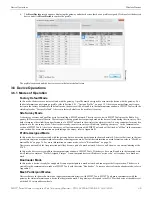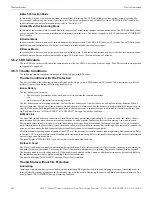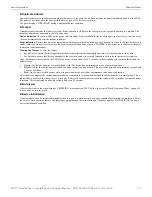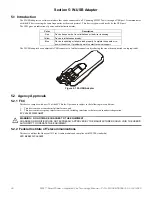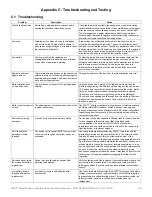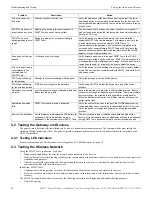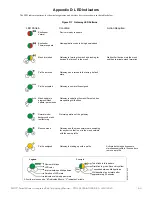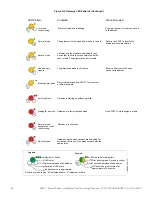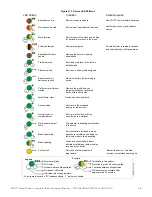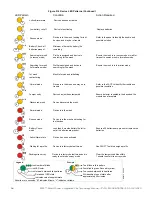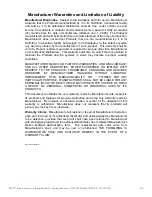
SWIFT® Smart Wireless Integrated Fire Technology Manual —
P/N LS10036-000SK-E:G 4/13/2020
49
Appendix C: Troubleshooting and Testing
C.1 Troubleshooting
Problem
Description
Action
Class A fault condition
Device has a single parent connection, and is
missing the redundant class A connection.
If a suitable parent is available, the background mesh restructuring
routine should self-heal the network. If the network does not self-heal
after ten minutes, reduce spacing between devices or utilize SWIFT
Tools for suggested repeater placement to add stronger parents.
Activate mesh formation to trigger a mesh restructuring routine to re-
evaluate the trouble condition after taking action.
Jamming
Jamming occurs when a device is overloaded
with an interfering RF signal and is unable to
process incoming messages, but is able to report
the condition to its parents.
A jammed device will automatically remove itself from the mesh
network after reporting the jamming. The device will attempt to self-
heal and recover into the network. Identify any possible sources of the
jamming signal and see if the spacing from the device to the jamming
source can be increased to an acceptable range. A site survey RF
scan test can be used to categorize the jamming signal.
Low battery
One or more of the four batteries are
missing/dead and/or the device has a minimum
of one week of operation remaining.
To clear the low battery event, tamper the device and replace all four
batteries. When a device is tampered, it drops out of the mesh
network and attempts to rejoin as soon as the batteries are replaced
and the tamper event is cleared. Once a low battery trouble is
indicated there is a minimum of one week of operation before the
device is non-functional.
Duplicate address/
Illegal address
Two or more wireless devices on the same mesh
network that are set to the same address report a
duplicate address trouble. An address set to zero
will report an illegal address.
Change the address of the device(s) to avoid duplication and error.
Mesh formation does
not find all devices
A device does not connect to the gateway/mesh
network
Verify the device has a profile. Verify that the profile matches the
profile in the gateway. Two different profiles may use the same mesh
ID. Remove and re-profile the device to guarantee the correct profile.
Verify the device is powered and the tamper condition is cleared.
Check to ensure the tamper magnet has not become dislodged.
Check the device spacing and the range from the device to the mesh.
A site survey link test can be used to verify connectivity from one
location to another.
Mesh restructuring does
not end
The gateway/mesh network appears to be stuck
in mesh restructuring
Use SWIFT Tools to investigate for the presence of interference such
as Walkie talkie/ RFID reader or unstable devices (dropping and
joining). Interference such as Walkie talkie/ RFID reader will prohibit
restructuring from fully executing. Devices joining a mesh will delay
the restructuring event.
Devices drop during
operation
A device drop event is indicated in history.
Device drop is the predecessor to a Missing trouble. Inspect the area
for any changes to the environment that could block radio
communication. Use a site survey RF Scan to check for any
interference and use a site survey link test to check the connectivity
from the device to its closest neighbor.
RF Overlap (Max
gateways) trouble
reported
The number of Honeywell SWIFT systems that
can co-exist in range of each other has been
exceeded.
Use the network statistics provided by SWIFT Tools to identify the
interfering networks and the nature of the fault. The networks will be
listed by a unique number; this is not the serial number of the
gateway. One or more of the systems will need to be powered down to
clear the fault. Where possible, maximize the number of devices on a
mesh network to reduce the number of total mesh networks; i.e. use
one mesh network with 50 devices instead of two mesh networks with
25 each. Restructure the layout of the mesh networks to group
devices and the gateway to avoid overlap. It may take 36 hours for the
fault to clear. This can be expedited by toggling the state of mesh
formation.
Device does not rejoin
the mesh after battery
replacement
Device is an invalid reply/no answer after
replacing the batteries.
Verify the tamper condition is cleared. Use mesh formation to have the
device rejoin the mesh network. Low battery and tamper are both
latching conditions. Ensure a reset has been initiated to clear those
events.
Low battery trouble
reported after battery
replacement
Low battery trouble is still indicated after
replacement.
Use the network statistics provided in SWIFT Tools to see the battery
voltage measured for each individual battery. Verify that each battery
is present and at a suitable voltage level. The low battery trouble is a
latching trouble, ensure a reset has been initiated since the
replacement.

